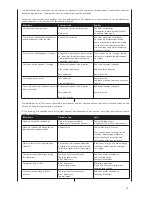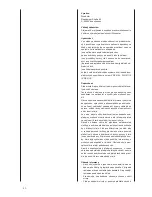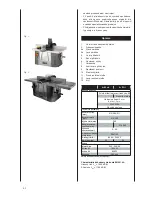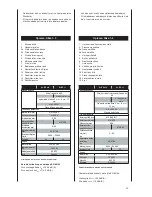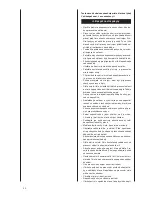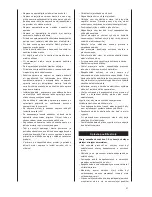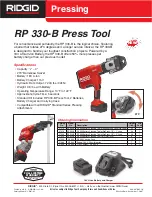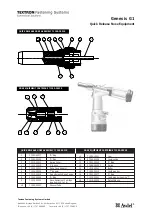
33
Utilization of the machine
s &ITANDSECURETHECUTTINGKNIVES
s !DJUSTTHESPEEDANDADJUSTTHEOUTPUTFENCEINSUCHA
way that the material cut is supported and a compensa-
tion for the material removed is achieved.
s 3WITCHTHEMACHINEON
s -AKESURETHEWORKPIECEISlRMLYPRESSEDAGAINSTTHE
fence.
s 0USHTHEWORKPIECESOFTLYFROMRIGHTTOLEFTAGAINSTTHE
turning direction of the tool.
s +EEPYOURFORWARDINGSPEEDCONSTANT$ONOTPUSHTOO
fast – it would slow down the motor too much.
s &EEDING THE WORK PIECE TOO FAST WILL RESULT IN A POOR
cutting quality. There is also the risk of damaging the
cutting knives or the motor.
s &EEDING THE WORK PIECE TOO SLOW WILL RESULT IN BURNT
spots on the work piece.
s 7ITHVERYHARDWOODANDIMPORTANTCUTSITCANBENEC
-
essary to work progressively in several cuts until the
desired depth is achieved.
s 4HECORRECTINTAKESPEEDDEPENDSONTHECUTTERSIZETHE
material type of the work piece, and the cutting depth.
It is recommended to practise first with a piece of scrap
wood in order to determine the correct intake speed and
the dimensions.
s 3WITCHTHEMACHINEOFFBYPRESSINGTHEREDCOVER
Symbols
The model plate on your machine can include symbols.
They contain important information regarding the use of
the machine.
Wear ear protection, goggles, and breathing mask.
Observe the applicable safety standards.
Maintenance
Warning:
Make always sure that the machine is switched
off and disconnected from the power supply before you
start any setting or maintenance work.
Store the machine, operating instructions and accessories
in a safe place. This way, the instructions and tools are
always at hand. Regularly remove dust and dirt. Cleaning
is preferably done with compressed air or a cloth.
During cleaning, wear goggles to protect your eyes.
Attention:
Do not use any aggressive cleaning agents on
the plastic parts of the table. We recommend a mild dish-
washing liquid on a damp cloth. Water must never come
into contact with the machine.
Utilisation
s -ONTERETRESSERRERLAFRAISE
s !JUSTER LA VITESSE !JUSTER LA BUTÏE DE SORTIE DE TELLE
FAÎONQUELLESUPPORTELEMATÏRIELCOUPÏETQUELLEEN
même temps, produise une compensation pour le ma-
TÏRIELÙTÏ
s -ETTREENMARCHELATOUPIE
s 3ASSURERQUELAPIÒCEËTRAVAILLERESTPRESSÏEFORTEMENT
vers la butée.
s &AIREGLISSERLAPIÒCEËTRAVAILLERDUNEMANIÒRESOUPLE
de droite à gauche contre la direction de rotation de
l’outil.
s -AINTENIRLAVITESSEDAVANCECONSTANTE.EPASPOUSSER
trop vite pour ne pas freiner trop le moteur.
s 0OUSSERTROPVITEPOURRAITDONNERUNEMAUVAISEQUALITÏ
de coupe. En outre, il pourrait endommager le fer de
fraise ou le moteur.
s 0OUSSER TROP LENTEMENT POURRAIT LAISSER DES TRACES DE
brûlure au bois.
s %NCASDEBOISTRÒSDURETDEGRANDESCOUPESILPEUT
être nécessaire de faire plus d’une passe lors d’un tra-
vail progressif, jusqu’à la profondeur désirée est obte-
nue.
s ,AVITESSEDAVANCEDÏPENDDELATAILLEDELAFRAISEDU
type de matériel du bois et de la profondeur de coupe.
Il est recommandé de tester avec une pièce de déchets
pour trouver la vitesse d’avance et les dimensions cor-
rectes.
s -ETTRELAMACHINEENMARCHEENAPPUYANTLECHAPEAU
rouge.
Symboles
La plaque signalétique de votre machine peut comprendre
des symboles. Ceux-ci contiennent des informations im-
portantes de l’utilisation du produit.
Il faut porter des protections pour les yeux et les oreilles,
et une masque contre la poussière.
Il faut aussi remplir les standards de sécurité applica-
bles.
Maintenance
Avertissement :
Avant d’entreprendre des travaux de régla-
ge ou de maintenance, toujours s’assurer que la machine
est à l’arrêt et que la fiche d’alimentation est débran-
chée.
Entreposer la machine, les instructions d’utilisation et
les accessoires dans un endroit sûr. De cette manière les
instructions et les outils sont toujours à portée de main.
Régulièrement enlever la poussière et les impuretés. Le
nettoyage se fait à l’air comprimé ou à l’aide d’un chif-
fon.
Lors du nettoyage, porter des lunettes de protection pour
protéger vos yeux.
Précautions à prendre:
Ne pas utiliser de produit de net-
toyage sur les parties en matière plastique de la table.





















